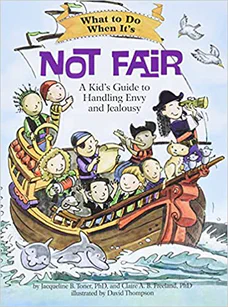What To Do When It’s Not Fair
A Kid’s Guide to Handling Envy and Jealousy
Written by Jacqueline B. Toner, Ph.D. and Claire A. B. Freeland, Ph.D.
Illustrated by David Thompson
96 pages
•
Published 2013 (Magination Press)

Recommended Age Range: 1st grade through 5th grade.
Publisher's Summary:
Just like a pirate using a spyglass, kids may focus in on one thing that they want, and not notice all the good things they already have. If you’re a kid who thinks “it’s not fair,” this book is for you! What to Do When It’s Not Fair guides children and their parents through the difficult emotions of envy and jealousy using strategies and techniques based on cognitive–behavioral principles. This interactive self-help book is the complete resource for educating, motivating, and empowering children to cope with envy — so they can sail the high seas with pleasure!

Dr. Annie's Takeaways
Recommended for: This interactive workbook based on Cognitive Behavioral Therapy
techniques helps children to learn cognitive restructuring
and relaxation
strategies to manage envy when something is “not fair.” It includes techniques to navigate situations when “someone else has something you think is better than what you have, or does something better than you, or gets more attention than you do.” This book is best for a child who has some insight into their thoughts (i.e., can name their thoughts about specific situations).
Would a child like it? This book isn’t the most fun of the workbooks in the “What to Do” series, but in small doses, the pirate metaphor and the book’s usefulness will likely help a child to stick it out.
Evidence-Based Practices:
Psychoeducation, Cognitive Restructuring, Relaxation, Diaphragmatic Breathing
Tone: Informative, motivating
Story Quality: This workbook uses an effective metaphor of a pirate with a spyglass to teach kids about different strategies for managing the feeling of envy. The techniques are described using child-friendly language, and I found the authors’ rationales for using the techniques to be motivating. There are interactive components to the workbook (e.g., “Can you list three envy thoughts that might pop into your head?”) that are useful but, for the most part, not particularly fun. There are a couple of activities that incorporate drawing, as well as a search-and-find, but most of the interactive pieces involve writing out different thoughts.
Illustrations: Black-and-white watercolor illustrations that supplement the text. Most pages have an illustration, but many pages are dominated by text.
Representation: Many different children are portrayed in the illustrations throughout the text (i.e., children with different skin tones, hair, and genders). A few examples include mentions of Mom or of Dad, but it is not explicitly implied that all children have a mom and a dad. Many of the examples include mention of a sibling, but there is specific acknowledgment that not all children have a sibling and that only children can feel envy too.
Psychological Practices: This workbook teaches children to identify the feeling of envy; which situations trigger their envy feelings; the impact of thoughts on feelings, and how shifting one’s thoughts can shift one’s feelings; different cognitive restructuring
strategies to use when navigating envy (e.g., “putting down your spyglass” to broaden one’s focus and notice the things one has rather than focusing on the things one doesn’t have, envy thoughts versus “challenge thoughts,” “forever thoughts” versus “for now” thoughts, and “every time” versus “this time” thoughts); increasing empathy when others are jealous; building a strong sense of self; and relaxation
strategies (i.e., deep breathing and yoga poses).
Concerns: This workbook assumes that situations are more or less fair and that a child’s feelings of envy are the result of over-focusing on aspects that aren’t fair. Often this is true (e.g., when a child is invited to a playdate with a friend next weekend, but they’re jealous of their other friend getting to play this weekend), but not always. Sometimes something is truly unjust (e.g., a parent favoring one child over another, or a teacher acting in ways that are discriminatory). This workbook does not address how a child might handle these types of situations. The Bookshelf section on Assertiveness and Self-Advocacy
might be a place to start these conversations.
